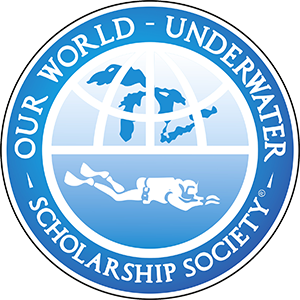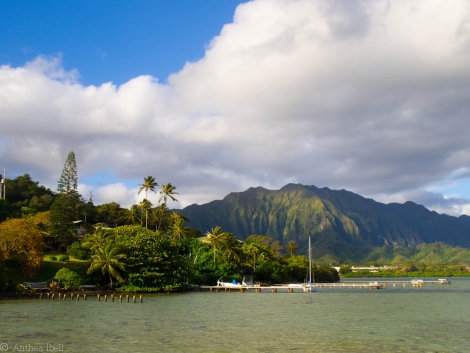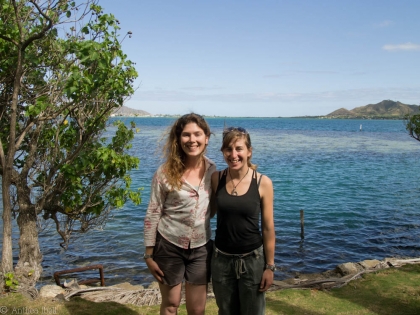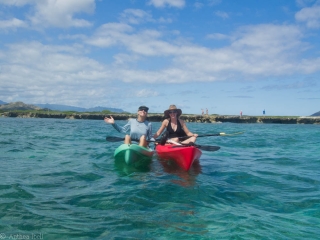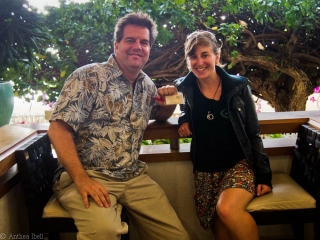I have talked to a lot of people who have said that Hawaii is one of the most beautiful spots they have seen. I wanted to experience it for myself after hearing Christian’s stories of shark tagging adventures. I visited Oahu for two weeks to gain some experience at the Hawai’i Institute of Marine Biology, meet people who are carrying out research and learn about the ocean related courses offered through the University. A flu meant I was unable to dive much during my stay but I was able to meet some very inspiring people.
The Marine Options Program at the University of Hawaii offers students the opportunity gain experience and knowledge related to the ocean, no matter what their area of study. Art students can make instillations or pieces about the ocean, business majors can create fishing related business models, anthropology students can learn about the interaction of humans and the sea. All of these projects can count as credit towards their studies. While I was listening to Jeff Kuwabawa, Marine Option Program Coordinator, I was thinking to myself how great it would be if more universities encouraged this kind of education about our ocean world.
While at the university I also spent a day in Jeff Drazen’s deep sea research lab. Jeff’s current projects are trying to learn more about the food web and ecology of deep fish species through isotope analysis. By looking at the chemical compounds in tissue they can gain information about diet and metabolism. Gut content analysis is also used but is a limited method when dealing with such challenging areas of the ocean.
The Hawaiian Institute of Marine Biology is located on Coconut Island, a small island in Kaneohe Bay on the Eastern side of Oahu. It is here that Christian’s shark tagging stories came from, and it is here that I visited for a day to try to catch a Hammerhead. James Anderson welcomed me to the Pelagic Lab and we set up the gear; 60+ hooks were baited with fish and squid, we got on the little boat and headed out into the bay. Oahu’s impressive mountain-scape surrounds the bay and we laid line with extraordinary views of the island. The lines were set for three hours and then retrieved. Unfortunately we didn’t catch anything but it was interesting learning the process. The Hammerheads are more common in the bay during summer months when the females come in to pup and the males follow them. The team at HIMB continues to set lines throughout the year as to have consistent efforts tagging the sharks.
By a fortunate coincidence, 2007 North American Scholar, Brenna Mahoney was visiting Coconut Island for post graduate research. I was able to meet her and share scholar stories! Brenna and another grad student’s work involved scouting for research sites so I joined them for a kayak in Kailua bay. 1993 North American Scholar, Katie Laing also came along for the day’s adventures. Katie and I caught up and paddled out to the Mokulual State Seabird Sanctuary.
Continuing with Scholar introductions, I met with Alan Hilton, 1986 scholar. After a 20 year career with NOAA, Alan is now the Technical Director for CEROS, the National Defence Center of Excellence for Research in Ocean Sciences. It was great to meet the past scholars and be inspired by their work since their year.
As a climax to my Hawaii visit I was able to go out whale watching with Gordon Tribble, Center Director USGS Pacific Island Ecosystems Research Center and John Ford from SWCA Environmental Consultants. We headed out from the marina and toward a dive site to the east. Within minutes there were Hampback Whale spouts heading toward us. We watched as a group of whales breached and finslapped a short distance from the boat!
I would like to thank Reagan and her parents, Todd and Ginger Grant for hosting me in their beautiful home. Thanks to Jane Schoonmaker, Jeff Drazen, Erica Aus, Kevin Weng, Gordon Tribble, John Ford, James Anderson, Dave Pence, Narineh Nazarian for all the amazing experiences I had during my stay in Hawaii. And thanks to the past scholars; Brenna Mahoney, Katie Laing and Alan Hilton.
